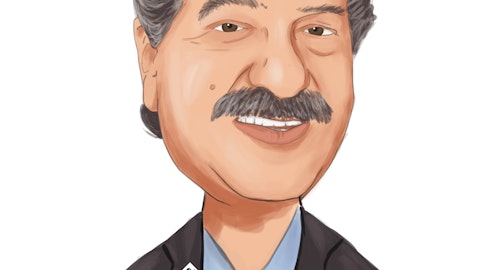John Arfstorm: Okay, alright. Thank you, very nice quarter.
Leslie Lunak: Thank you.
Raj Singh: Thank you.
Operator: Thank you. [Operator Instructions] Our next question is going to come from the line of Steven Alexopoulos with JPMorgan. Your line is open. Please go ahead.
Janet Lee: Good morning. This is Janet Lee on for Steven Alexopoulos. All I want to go back to reserves for a second and how the higher rate forecast for Moody’s is the largest driver of the build in reserves. Is this really tied to your assumption that rates higher for longer will increase the odds of a recession?
Leslie Lunak: It’s not tied to our assumption. It’s the assumption that’s embedded in the Moody’s economic forecast that we see to model.
Tom Cornish: Moody’s assumption.
Leslie Lunak: Yes, it’s Moody’s assumption. This is [Indiscernible] Assumption. But it is certainly tied to the fact that in the model, a higher rate environment will put some stress on maturing and repricing loans, and that’s the driver. I mean these models are extraordinarily complex Janet. But yes, at a high level, that’s what’s going on there. And there are other things that work in there, too. That was just the one that had the most impact.
Janet Lee: Right. Okay. Because when I was looking — when I was comparing Moody’s August and May forecast unemployment assumption hasn’t changed through 2025 [Indiscernible]
Leslie Lunak: Actually at a regional level, the trajectory of the unemployment path has changed. I know everybody wants to look at the national unemployment rate in national GDP and correlate to that, but these models are just far more complex than that. And I can’t get into all those details. It’s just there’s a lot going — my point there’s a lot going on in there besides just national unemployment and national GDP.
Janet Lee: Okay. So your scenario contemplates like local is not just generic national?
Leslie Lunak: Yes, that’s how these — our models work. It’s based that it’s done at the submarket level. Yes.
Janet Lee: Okay. Got it. And — can you remind me what unemployment rate is embedded in your current reserves then?
Leslie Lunak: Well, it’s different in New York than in Florida. It’s different in Miami than in Tampa. It’s different — so that’s a pretty complex question. But it averages somewhere. It averages somewhere in the low-4s.
Janet Lee: Okay. And just following up on reserves. Looking at the franchise finance segment, are you seeing any stress building in that segment it looks like lower, but it looks like more.
Leslie Lunak: It’s really 1 loan, Janet, that migrated down to nonaccrual this quarter and then we put some specific reserves on — and it’s a kind of a coded leftover, I would say. They just never were able to dig their way out.
Janet Lee: Okay. Got it. And last question on NIM and NII. So is it fair to say like theoretically speaking, you’ll get more benefit from NIM point of view, if the Fed cuts rates sooner when considering your portfolio mix? Or do you get more benefits if rates stay higher for longer and benefits the fixed asset repricing?
Leslie Lunak: To be honest, Janet, it’s the most impactful thing is mix. By far. By far. Funding mix and loan mix are far more impactful. The balance sheet — the static balance sheet is relatively neutral from an interest rate risk perspective. So mix how the mix evolves is the thing that really will impact the NIM much more so than what the Fed does or doesn’t do.
Tom Cornish: DDA growth. That’s why it’s the number 1 priority in the bank.
Janet Lee: Alright, thank you.
Leslie Lunak: You’re welcome.
Operator: Thank you. [Operator Instructions] And our next question is going to come from the line of David Bishop with Hovde Group. Your line is open. Please go ahead.
David Bishop: Yes, thank you. Good morning.
Raj Singh: Good morning, David.
David Bishop: Quick question, Raj, Leslie, you guys have done a nice job tamping down the level of expense growth. Anything looming? I know you haven’t done budgets for next year, but anything that could drive that growth rate materially higher next year? Are there any pending team lift-outs or teams you’re targeting that could move the needle there materially?
Raj Singh: Actually, we forgot to mention on this call that we did hire a C&I head for Texas. So last quarter, I think we told you about the CRE business had been launched. Took us a little longer than I would have wanted on the C&I front, but a press release on that hiring will be going out in the next day or two. So outside of that, we’re always looking — we did make some good hires in April, May time frame. So there’s nothing in particular that jumps out that there’s a big theme or anything, but there are always producers that we’re bringing in. At the same time, remember, we’re keeping expenses flat. So there are some people that were changing out as well. our focus is so much on deposit growth and DDA growth. If you don’t cut that, your incentive plan may have changed so much that some people may choose to not be here.




